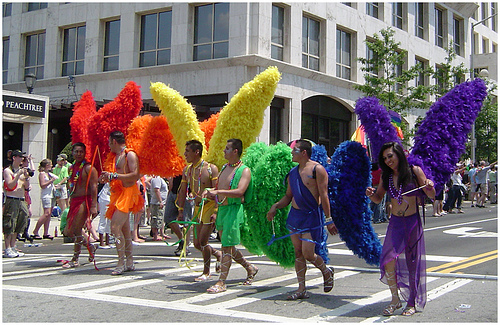Where Are the American Fairies? February 6, 2014
Author: Beach Combing | in : Modern , trackbackFirst of all a nod to an interesting article that has appeared in an interesting blog: ‘Turn your cloak for the Fairy Folk’ (New England Folklore). The author (Peter Muise) asks a fascinating question: why is it that fairylore never caught on in the New World? He quotes Owen Davies (a wanw British scholar) to the effect that there was a lack of landscape features with a long fairy history. Now, in fact, fairylore did catch on in the New World but patchily. As a discussion under the article notes in Atlantic Canada there are extremely strong fairy traditions: arguably as strong as in western Ireland and Highland Scotland. In New England though fairy traditions seem to have been practically nil. The question then is not why weren’t there fairies in the New World, but why fairies flourished in place X but not place Y.
The answer surely has nothing to do with landscape and everything to do with origins. In North America, after Small Pox and manifest destiny had done their worst there was no pre-existing tradition to fuse with: the contrast with Latin America is striking in that respect. Everything depended on where migrant communities came from. Atlantic Canada had a strong, by some estimates an overwhelming ‘Gaelic’ makeup: indeed, Gaelic survives on the fringes of Atlantic Canada to this day. The Gaels brought their fairies with them and their banshees and within a generation parts of the landscape were marked down as ‘uncanny’.
New England has, according to PM, a largely East Anglian background. If that is, indeed, so (embarrassing lack of knowledge on my part) then this is interesting as EA is the region of Britain (along with Kent) with the least fairy history: check out Janet Bord’s fairy map. PM has found one source for fairy belief in New England and that is (probably) Judge Joseph Story (obit 1845), who was told by his mother to ‘to turn his jacket inside out for fear of the pixies’. Here the rule of origins seems to hold though. ‘Pixies’ suggest a south-western background for Story’s mother and sure enough she has a classic south-western surname Pedrick. Her father John Pedrick was likely a first or second generation Cornubian who had brought pixies over with him in his suitcase.
If this theory of origins holds then it should be able to look at a map of European settlement in the New World and predict where fairy traditions would be strongest. Other thoughts on fairies and the Americas: drbeachcombing AT yahoo DOT com
7 Feb 2014: Several comments here. First Michel C makes an interesting point that if the whole origin thing works then fairies should turn up in other destinations including Australia. I suspect that Australia has too mixed a population for that (even in the early phase). But I would love to know whether Welsh fairies made it to Patagonia. Karl Bell (on twitter) protests that East Anglia has other supernatural creatures and that this is a classification problem. I would say that even if you define fairies widely to take in solitary and ‘normal’ fairies – anything humanoid, living and supernatural – then you will still find that East Anglia and Kent are underrepresented. Did the East Anglian black dog make it across perhaps to New England? Then Chris S gives a poetic flourish pointing out that Alien Greys are the American fairy! Love that! Thanks to all!
29 May 2017: Leif writes, ‘Forgive a comment which does not address your query [Leif posted for this post I shifted it here]. By coincidence, I had just read the folklore section of Evans Wentz book. One tale, which follows in entirety, strikes me as entirely singular: Chapter 2, The taking of evidence; part 3, In Scotland; The testimony of Murdoch MacLean, Lachlann’s Fairy Mistress. ‘My grandmother, Catherine MacInnis, used to tell about a man named Lachlann, whom she knew, being in love with a fairy woman. The fairy woman made it a point to see Lachlann every night, and he being worn out with her began to fear her. Things got so bad at last that he decided to go to America to escape the fairy woman. As soon as the plan was fixed, and he was about to emigrate, women who were milking at sunset out in the meadows heard very audibly the fairy woman singing this song: What will the brown-haired woman do when Lachlann is on the billows? ‘Lachlann emigrated to Cape Breton, landing in Nova Scotia; and in his first letter home to his friends he stated that the same fairy woman was haunting him there in America.’ In an endnote, Evans Wentz compares the fairy woman with a sucubbi, which sounds fairly straightforward. But what appears unique (to this writer, at least) is the theme of immigration. Not only does the man immigrate, but the fairy as well. Dr. Beachcombing has previously discussed the immigration of fairy traditions [Wrong Time Bread, Wrong Place Fairies September 19, 2016], but are there any other accounts of fairies and immigration?



